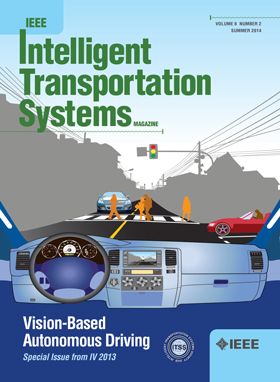将运动原型作为深度 Q 学习的动作空间,用于自动驾驶规划
IF 7.9
1区 工程技术
Q1 ENGINEERING, CIVIL
IEEE Transactions on Intelligent Transportation Systems
Pub Date : 2024-09-24
DOI:10.1109/TITS.2024.3436530
引用次数: 0
摘要
自动驾驶车辆的运动规划通常通过图搜索方法来实现,这种方法对模型精度和环境复杂性造成了限制,无法在实时约束条件下进行处理。相比之下,强化学习,特别是深度 Q 学习(DQL)算法,为实时解决方案提供了一个有趣的替代方案。一些方法,如深度 Q 网络(DQN),通过量化连续控制输入来模拟 RL 动作空间。在此,我们建议使用运动基元,将连续时间非线性系统行为编码为动作空间。在一个数值示例中,我们使用单轨车辆模型和不同的规划场景对运动基元-DQL 规划的新方法进行了评估。结果表明,我们的方法在计算时间和到达目标的概率上都优于最先进的图搜索方法。本文章由计算机程序翻译,如有差异,请以英文原文为准。
Motion Primitives as the Action Space of Deep Q-Learning for Planning in Autonomous Driving
Motion planning for autonomous vehicles is commonly implemented via graph-search methods, which pose limitations to the model accuracy and environmental complexity that can be handled under real-time constraints. In contrast, reinforcement learning, specifically the deep Q-learning (DQL) algorithm, provides an interesting alternative for real-time solutions. Some approaches, such as the deep Q-network (DQN), model the RL-action space by quantizing the continuous control inputs. Here, we propose to use motion primitives, which encode continuous-time nonlinear system behavior as the action space. The novel methodology of motion primitives-DQL planning is evaluated in a numerical example using a single-track vehicle model and different planning scenarios. We show that our approach outperforms a state-of-the-art graph-search method in computation time and probability of reaching the goal.
求助全文
通过发布文献求助,成功后即可免费获取论文全文。
去求助
来源期刊

IEEE Transactions on Intelligent Transportation Systems
工程技术-工程:电子与电气
CiteScore
14.80
自引率
12.90%
发文量
1872
审稿时长
7.5 months
期刊介绍:
The theoretical, experimental and operational aspects of electrical and electronics engineering and information technologies as applied to Intelligent Transportation Systems (ITS). Intelligent Transportation Systems are defined as those systems utilizing synergistic technologies and systems engineering concepts to develop and improve transportation systems of all kinds. The scope of this interdisciplinary activity includes the promotion, consolidation and coordination of ITS technical activities among IEEE entities, and providing a focus for cooperative activities, both internally and externally.
 求助内容:
求助内容: 应助结果提醒方式:
应助结果提醒方式:


